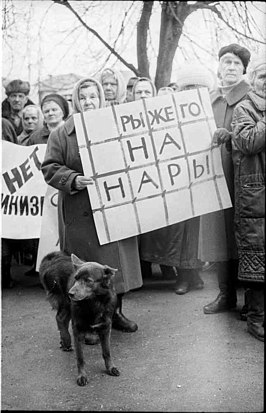
Back الخصخصة في روسيا Arabic Прыватызацыя ў Расеі BE-X-OLD Privatizace v Rusku Czech Ιδιωτικοποιήσεις στη Ρωσία Greek Privatizaciones rusas Spanish خصوصیسازی در روسیه Persian Yksityistäminen Venäjällä Finnish Privatizacija u Rusiji Croatian Սեփականաշնորհումը Ռուսաստանում Armenian Приватизација во Русија Macedonian
This article needs additional citations for verification. (September 2011) |

Privatization in Russia describes the series of post-Soviet reforms that resulted in large-scale privatization of Russia's state-owned assets, particularly in the industrial, energy, and financial sectors. Most privatization took place in the early and mid-1990s under Boris Yeltsin, who assumed the presidency following the dissolution of the Soviet Union.
Private ownership of enterprises and property had essentially remained illegal throughout the Soviet era, with Soviet Communism emphasizing national control over all means of production but human labor.[1] Under the Soviet Union, the number of state enterprises was estimated at 45,000.[2]
Privatization facilitated the transfer of significant wealth to a relatively small group of business oligarchs and New Russians, particularly natural gas and oil executives.[3] This economic transition has been described as katastroika,[4] which is a combination of catastrophe and the term perestroika, and as "the most cataclysmic peacetime economic collapse of an industrial country in history".[5]
A few strategic assets, including much of the Russian defense industry, were not privatized during the 1990s. The mass privatization of this era remains a highly contentious issue in Russian society, with many Russians calling for revision or reversal of the reforms.[6]
- ^ Hoffman 2001, p. 185.
- ^ Jeffrey Sachs (May 1992). "Privatization in Russia: Some Lessons from Eastern Europe" (PDF). AEA Papers and Proceedings.
- ^ Freeland 2000, p. 73.
- ^ "A Way with Words - katastroika". 11 July 2004. Retrieved 27 June 2015.
- ^ Milne, Seumas (16 August 2001). "Catastroika has not only been a disaster for Russia". The Guardian. Retrieved 17 September 2011.
- ^ Interfax; Interfax (2014-12-29). "Most Russians are negative about outcome of Yeltsin's presidency - poll". www.rbth.com. Retrieved 2021-12-15.